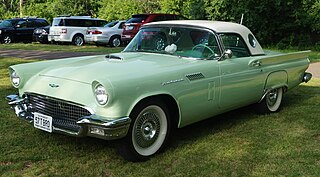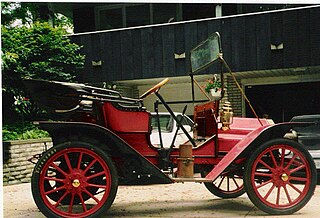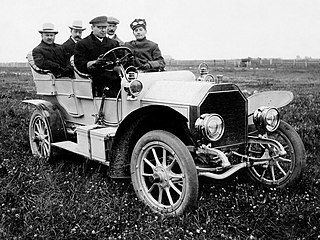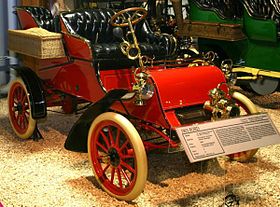
The Ford Model C is an automobile that was produced by Ford Motor Company. Introduced in late 1904, the Model C was Ford's lower priced 1905 model. The first sales were in October 1904, with most sold during the 1905 calendar year. Horace Dodge made major changes to the design of the engine, rear axle and other parts of the car. The Model C used the same 10 hp motor the 1904 Model A was equipped with. Model C had a longer wheelbase than the earlier Model A. Built at the Ford Piquette Avenue Plant, it was the entry-level car in the Ford model lineup, slotting below the upscale Model B. Production ended in 1905 with approximately 1,000 cars produced. About 160-170 Model C were assembled in Canada at Ford's new Ford Canada location in Walkerville. Due to the Dodge Brothers owning a ten percent share of the company, as well as supplying many parts and assemblies, the Model C took to the road with Dodge-built engines and other key assemblies.

Elmore Manufacturing Company was a manufacturer of veteran and brass era automobiles and bicycles (1893–97), headquartered at 504 Amanda Street, Clyde, Ohio, from 1893 until 1912. The company took its name from a small parcel of land in Clyde with the name Elmore associated with it where a stave mill was established originally, then evolved into bicycle production. The village of Elmore, Ohio is located 20 mi (32.2 km) to the east. Founded by Harmon Von Vechten Becker and his two sons, James and Burton, the Elmore used a two-stroke engine design, in straight twin or single-cylinder versions. They later produced a straight-3 followed by a straight-4 beginning in 1906 until production ended in 1912. The company advertising slogan was "The Car That Has No Valves", referring to the two-stroke engine.

E. R. Thomas Motor Company was a manufacturer of motorized bicycles, motorized tricycles, motorcycles, and automobiles in Buffalo, New York between 1900 and 1919.

The first Cadillac automobiles were the 1903 Model built in the last quarter of 1902. These were 2-seater "horseless carriages" powered by a reliable and sturdy 10 hp (7 kW) single-cylinder engine developed by Alanson Partridge Brush and built by Leland and Faulconer Manufacturing Company of Detroit, of which Henry Leland was founder, vice-president and general manager.

F. B. Stearns and Company, later known as F. B. Stearns Company was an American manufacturer of luxury cars in Cleveland, Ohio marketed under the brand names Stearns from 1900 to 1911 then Stearns-Knight from 1911 until 1929.

The Ford Fairlane 500 Skyliner is a two-door full-size retractable hardtop convertible, manufactured and marketed by Ford Motor Company for model years 1957–1959. However, early into the 1959 model year, its name was expanded to Fairlane 500 Galaxie Skyliner. The retracting roof system was marketed as the Hide-Away Hardtop, and was exclusively sold on this Ford-branded model, for three model years.

Marquette was an American automobile manufacturer established by General Motors in 1909 after the purchase of the Rainier Motor Car Company. The Marquette Company did not last long and in 1912 GM announced the company would be closed.

The first generation of the Ford Thunderbird is a two-seat convertible produced by Ford for the 1955 to the 1957 model years, the first 2-seat Ford since 1938. It was developed in response to the 1953 Motorama display at the New York Auto Show, which showed the Chevrolet Corvette. The Corvette in turn was developed in response to the popularity of European sports cars among Americans.

The third generation of the Ford Thunderbird is a personal luxury car produced by Ford for the 1961 to 1963 model years. It featured new and much sleeker styling than the second generation models. Sales were strong, if not quite up to record-breaking 1960, at 73,051 including 10,516 convertibles. A new, larger 390 cu in (6.4 L) FE-series V8 was the only engine available. The Thunderbird was 1961's Indianapolis 500 pace car, and featured prominently in US President John F. Kennedy's inaugural parade, probably aided by the appointment of Ford executive Robert McNamara as Secretary of Defense.

The Buick Model B was Buick's first model as an independent company, later becoming part of General Motors in 1908. It was built in Jackson, Michigan. A model B was exhibited in 1905 at the New York Auto Show as a promotion of the model C which would be the same. William C. Durant introduced the car himself at the exhibit, and took new car orders at the car show, raising sales from 37 cars in 1904 to 750 in 1905. It had a 2-cylinder, horizontally opposed engine – the world's first production OHV engine – installed lengthwise within the frame, and had a planetary transmission with a cone clutch and two forward speeds, plus one reverse gear. The engine was rated at 21 bhp. In later years, it was renamed as improvements were made. The chassis was shared later with the Oldsmobile Model 20 when they became a division of GM while the overhead valve engine wasn't used by Oldsmobile. It had a retail price of US$950 for the touring sedan.

The Packard Motor Car Company introduced their first four-cylinder engine in 1903 initially as a top level car along with the Packard Model F. It was their only automobile offered and exclusively used a four-cylinder engine from 1903 until 1912 and established Packard as a luxury car maker, and was replaced by the 1913 Packard Six.

The Lincoln EL-Series is a full-size luxury car that was marketed and sold by Lincoln from 1949 to 1951. Replacing the H-Series Lincoln, the postwar model line was the first complete redesign of the Lincoln sedan line since 1936. In line with its predecessor, the EL-Series Lincoln carried only the Lincoln nameplate, using no divisional branding; the Lincoln was slotted below the Lincoln Cosmopolitan within the Lincoln model range.

The Chevrolet Series L Light Six was an American car produced by Chevrolet in 1914 and 1915. The Chevrolet 'Bow Tie' emblem debuted in 1914 and has been used on all Chevrolet cars and trucks since. When the Classic Six ceased production at the end of the 1914 model year the Light Six replaced it in 1915 as Chevrolet's top-of-the-line offering.

The Buick 4 was a series of passenger cars produced by the Buick Division of GM from 1909 through 1918, and was available as a touring car, phaeton or roadster. It was available with the Buick Model B as a larger alternative offering a larger engine and better durability. It became the junior sedan in 1914 when the Buick Six was introduced.
The Welch Motor Company was an American automobile company headquartered in Chelsea, Michigan. It began in 1901 and continued production of luxury vehicles until 1911 when it merged with General Motors.

The Model S was the first four-seat passenger car produced by Oldsmobile in 1906, offered as a larger alternative to the Model R Curved Dash runabout that appeared in 1901. The advertised price was $2,250. It was Oldsmobile's first four cylinder car and took the top level marketing position above the Model L and the entry-level Model R. It was one of the last independently developed products before they joined General Motors in 1908, and competed against Buick, Ford and other automakers at the time. It was built at the Oldsmobile factory in Detroit and developed by Frederick and Angus Smith, whose father Samuel L. Smith was the primary investor, and R. E. Olds had left the company due to an argument with Oldsmobile Board of Directors.
The Model 42 was an entry-level four seat passenger car produced by GM's Oldsmobile Division in 1914. It was offered as a replacement to the Oldsmobile Curved Dash runabout when it was discontinued in 1908, and was the junior platform to the Oldsmobile Six introduced in 1913. GM had acquired Elmore Manufacturing Company, Oldsmobile and Oakland Motor Car Company in 1908 and Cartercar and Rainier Motor Car Company in 1909 as their entry-level models, and Oldsmobile products were being repositioned in their new hierarchy as GM began to consolidate operations after William Durant had left.

The Model D was a four-seat passenger car produced by General Motors under the Oldsmobile brand in 1909, replacing the Model M. It was the last car engineered by Oldsmobile before it became a division of GM and began sharing a platform with Buick.

The Oldsmobile Model Z was the company's first top-level passenger car produced under the Oldsmobile brand before they became a division of General Motors in 1908. The Model Z was created and engineered after Mr. Olds left the company but before they became a division, the same year the car was introduced. It was the senior model to the mid-level Oldsmobile Model M, and the entry-level, Buick engineered Oldsmobile Model 20. It was upgraded to become the Oldsmobile Limited.

The Model X was a four-seat passenger car produced by Oldsmobile in 1908, offered as an entry-level alternative to the Model D that appeared in 1901, replacing the Model M. It was the junior companion to the first six-cylinder sedan called the Oldsmobile Model Z also introduced in 1908, and shared most of its technology with the Model M.



















